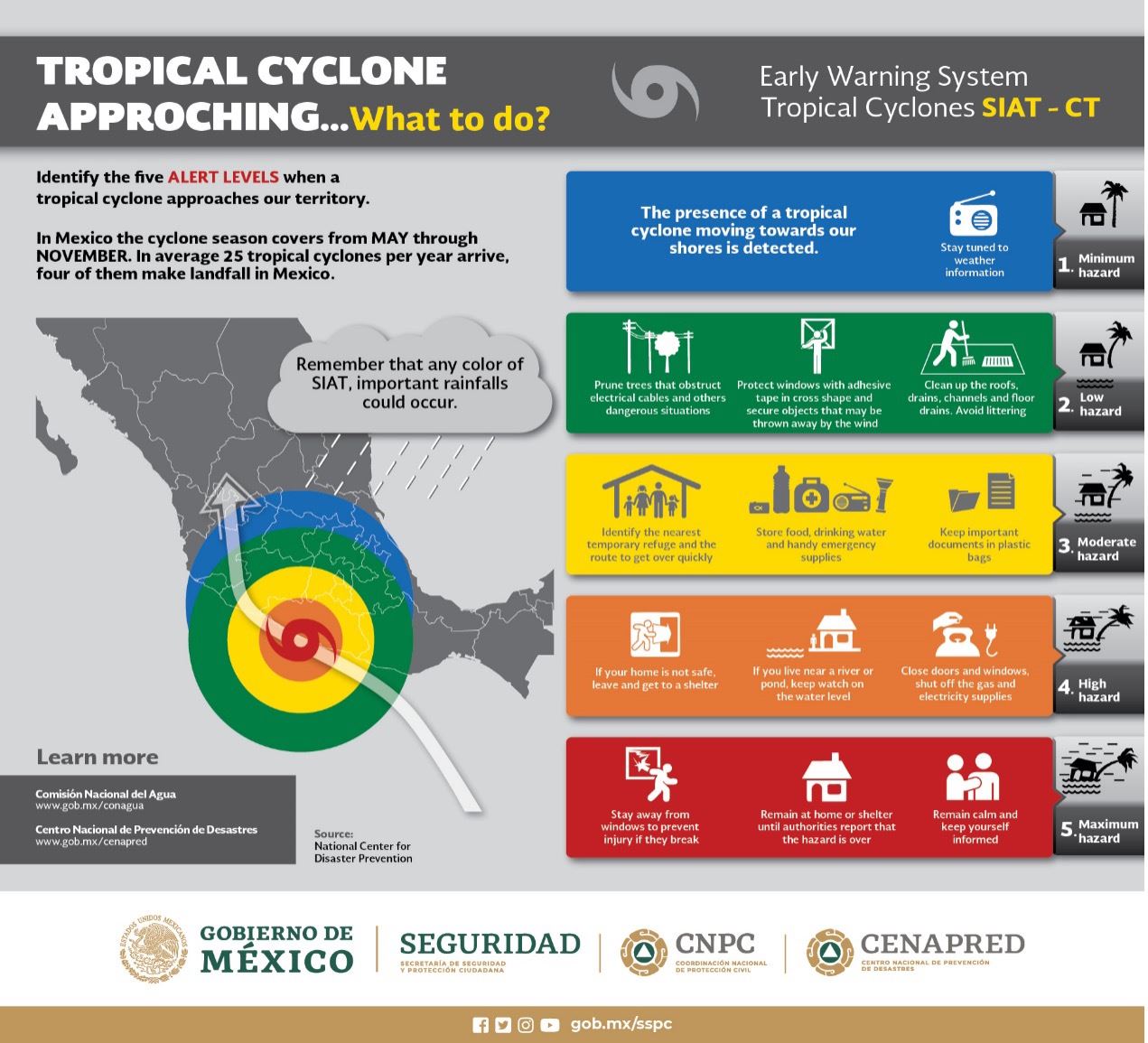
- Home
- News
- La Voz de Vecinos - English
- La Voz - June 2023 - English
- Hurricane preparedness
Hurricane season is June 1 to November 30
Creating a hurricane preparedness plan is an important step in ensuring the safety and well-being of yourself and your loved ones during a hurricane
 Here's a comprehensive guide to help you develop a solid hurricane preparedness plan:
Here's a comprehensive guide to help you develop a solid hurricane preparedness plan:
1. Stay informed:
- Monitor local weather updates and stay informed about any approaching hurricanes through reliable sources like the U.S. National Hurricane Center (nhc.noaa.gov), CONAGUA – Mexico’s weather service (https://twitter.com/conagua_clima or https://smn.conagua.gob.mx/es/), Local Facebook pages, (e.g., https://web.facebook.com/CoeprocQRoo, https://web.facebook.com/AyuntamientoDeTulum), or local news channels
- Get to know the alert system.

- Alerta Azul: Lowest Level of danger, remain vigilant. Updates every 12 hours.
- Alerta Verde: Second level of alert that there is the probability of an event, remain vigilant. Updates every 12 hours.
- Alerta Amarilla: Third level of alert, the moderate danger of an event, and preparations should begin for an event. Updates every 6 hours.
- Alerta Naranja: High probability of an event -Danger. At this level of alert, you should have a clear plan of evacuation if ordered, know your sheltersites or area of refuge, and have all of your supplies and measures in place to ride out the event. Many Municipalities will issue a stop-work order and businesses will be told to close down at a specific hour. Updates every 3 hours.
- Alerta Roja: Maximum Danger. Landfall is imminent. Shelter in place. Updates every 3 hours.
2. If you're a U.S. citizen, enroll in the U.S. State Department Smart Traveler Program to stay informed (https://step.state.gov/step/)
3. Develop an evacuation plan:
- Determine whether you live in an evacuation zone and familiarize yourself with the designated evacuation routes.
- Create a plan for where you will go in the event of an evacuation, such as a friend's or relative's house, a hotel, or a designated shelter. Many people drive inland to Valladolid or Merida.
- Make arrangements for your pets! Identify pet-friendly accommodations or make alternative arrangements for their safety.
4. Prepare an emergency kit by assembling a well-stocked emergency kit that includes essential supplies to last for at least 72 hours. This kit should include:
- Non-perishable food items AND a manual can opener
- Bottled water (1 gallon per person per day)
- Prescription medications and a first aid kit
- Flashlights, batteries, and a battery-powered radio
- Personal hygiene items and sanitary supplies
- Cash as we may have power outages and ATM’s will not be working.
- Important documents (identification, insurance papers, etc.)
- Extra clothing, blankets, and pillows
- Cell phone chargers and a portable power bank
5. Secure your property:
- Trim palm trees and shrubs around your home to minimize potential damage from falling fronds/branches.
- Reinforce doors and windows, or consider installing hurricane shutters.
- Clear your yard of any loose items that can become projectiles during high winds these include potted plants, beach chairs, umbrellas, kayaks, bicycles etc.
6. Create a communication plan:
- Establish a communication plan with your family and friends. Share contact information and determine a primary meeting point in case you get separated.
- Keep your cell phones fully charged and have backup batteries or portable chargers available.
- Identify an out-of-town contact person who can serve as a central point of communication.
- If you’re in town ask to join our “Hurricane Hustle" WhatsApp group it was formed as a way for neighbors who are in town during hurricane season to check up on one another during a storm.
7. Protect important documents:
- Make digital copies or take photographs of important documents (insurance policies, identification, etc.) and store them in a secure cloud-based storage system.
- Store physical copies of essential documents in a waterproof and portable container.
8. During a hurricane:
- Follow evacuation orders promptly, if issued. Don't wait until the last minute.
- Stay indoors and away from windows, seeking shelter in a small, windowless interior room.
- Listen to weather updates and official instructions from local authorities.
- Use battery-powered sources of light and avoid using candles to prevent the risk of fire.
- Do not attempt to drive through flooded areas. Turn around and find an alternate route.
9. Additional informational resources can be accessed here:
- https://mexicorelocationguide.com/8-tips-to-prepare-for-a-hurricane/
- https://www.redcross.org/get-help/how-to-prepare-for-emergencies/types-of-emergencies/hurricane.html
- NOAA National Hurricane Center preparedness videos on YouTube: https://www.youtube.com/user/NWSNHC
- https://www.ready.gov/